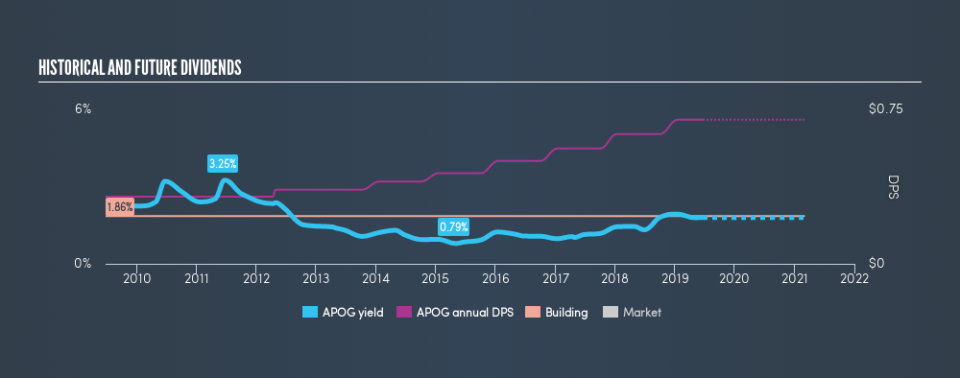Why Dividend Hunters Love Apogee Enterprises, Inc. (NASDAQ:APOG)

Want to participate in a short research study? Help shape the future of investing tools and you could win a $250 gift card!
Today we'll take a closer look at Apogee Enterprises, Inc. (NASDAQ:APOG) from a dividend investor's perspective. Owning a strong business and reinvesting the dividends is widely seen as an attractive way of growing your wealth. Yet sometimes, investors buy a popular dividend stock because of its yield, and then lose money if the company's dividend doesn't live up to expectations.
A 1.8% yield is nothing to get excited about, but investors probably think the long payment history suggests Apogee Enterprises has some staying power. The company also bought back stock during the year, equivalent to approximately 4.3% of the company's market capitalisation at the time. There are a few simple ways to reduce the risks of buying Apogee Enterprises for its dividend, and we'll go through these below.
Explore this interactive chart for our latest analysis on Apogee Enterprises!
Payout ratios
Dividends are usually paid out of company earnings. If a company is paying more than it earns, then the dividend might become unsustainable - hardly an ideal situation. As a result, we should always investigate whether a company can afford its dividend, measured as a percentage of a company's net income after tax. In the last year, Apogee Enterprises paid out 39% of its profit as dividends. This is a middling range that strikes a nice balance between paying dividends to shareholders, and retaining enough earnings to invest in future growth. One of the risks is that management reinvests the retained capital poorly instead of paying a higher dividend.
In addition to comparing dividends against profits, we should inspect whether the company generated enough cash to pay its dividend. The company paid out 50% of its free cash flow, which is not bad per se, but does start to limit the amount of cash Apogee Enterprises has available to meet other needs. It's encouraging to see that the dividend is covered by both profit and cash flow. This generally suggests the dividend is sustainable, as long as earnings don't drop precipitously.
Consider getting our latest analysis on Apogee Enterprises's financial position here.
Dividend Volatility
From the perspective of an income investor who wants to earn dividends for many years, there is not much point buying a stock if its dividend is regularly cut or is not reliable. Apogee Enterprises has been paying dividends for a long time, but for the purpose of this analysis, we only examine the past 10 years of payments. The dividend has been stable over the past 10 years, which is great. We think this could suggest some resilience to the business and its dividends. During the past ten-year period, the first annual payment was US$0.33 in 2009, compared to US$0.70 last year. This works out to be a compound annual growth rate (CAGR) of approximately 7.9% a year over that time.
Companies like this, growing their dividend at a decent rate, can be very valuable over the long term, if the rate of growth can be maintained.
Dividend Growth Potential
Dividend payments have been consistent over the past few years, but we should always check if earnings per share (EPS) are growing, as this will help maintain the purchasing power of the dividend. It's good to see Apogee Enterprises has been growing its earnings per share at 11% a year over the past 5 years. A company paying out less than a quarter of its earnings as dividends, and growing earnings at more than 10% per annum, looks to be right in the cusp of its growth phase. At the right price, we might be interested.
Conclusion
When we look at a dividend stock, we need to form a judgement on whether the dividend will grow, if the company is able to maintain it in a wide range of economic circumstances, and if the dividend payout is sustainable. Above all, we're glad to see that Apogee Enterprises pays out a low fraction of its earnings and, while it paid a higher percentage of cashflow, this also was within a normal range. That said, we were glad to see it growing earnings and paying a fairly consistent dividend. All things considered, Apogee Enterprises looks like a strong prospect. At the right valuation, it could be something special.
Earnings growth generally bodes well for the future value of company dividend payments. See if the 5 Apogee Enterprises analysts we track are forecasting continued growth with our free report on analyst estimates for the company.
Looking for more high-yielding dividend ideas? Try our curated list of dividend stocks with a yield above 3%.
We aim to bring you long-term focused research analysis driven by fundamental data. Note that our analysis may not factor in the latest price-sensitive company announcements or qualitative material.
If you spot an error that warrants correction, please contact the editor at editorial-team@simplywallst.com. This article by Simply Wall St is general in nature. It does not constitute a recommendation to buy or sell any stock, and does not take account of your objectives, or your financial situation. Simply Wall St has no position in the stocks mentioned. Thank you for reading.

 Yahoo Finance
Yahoo Finance 
